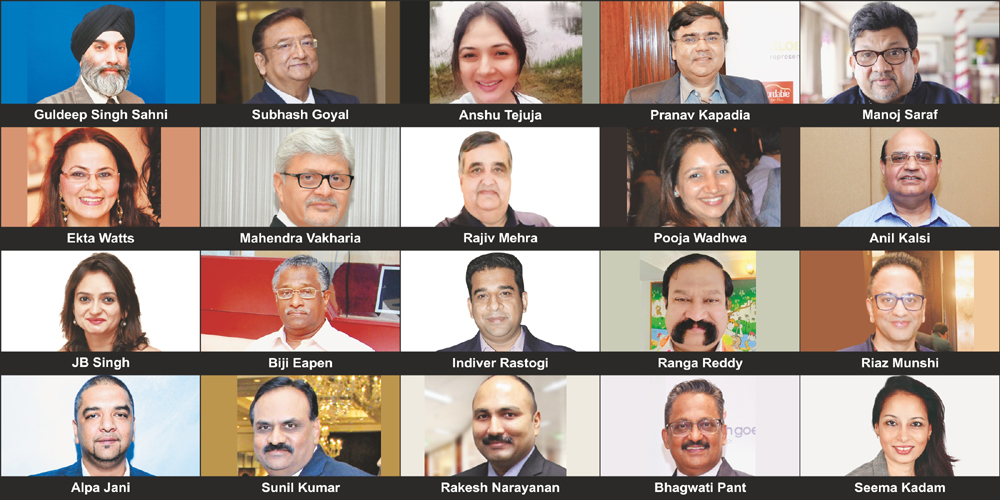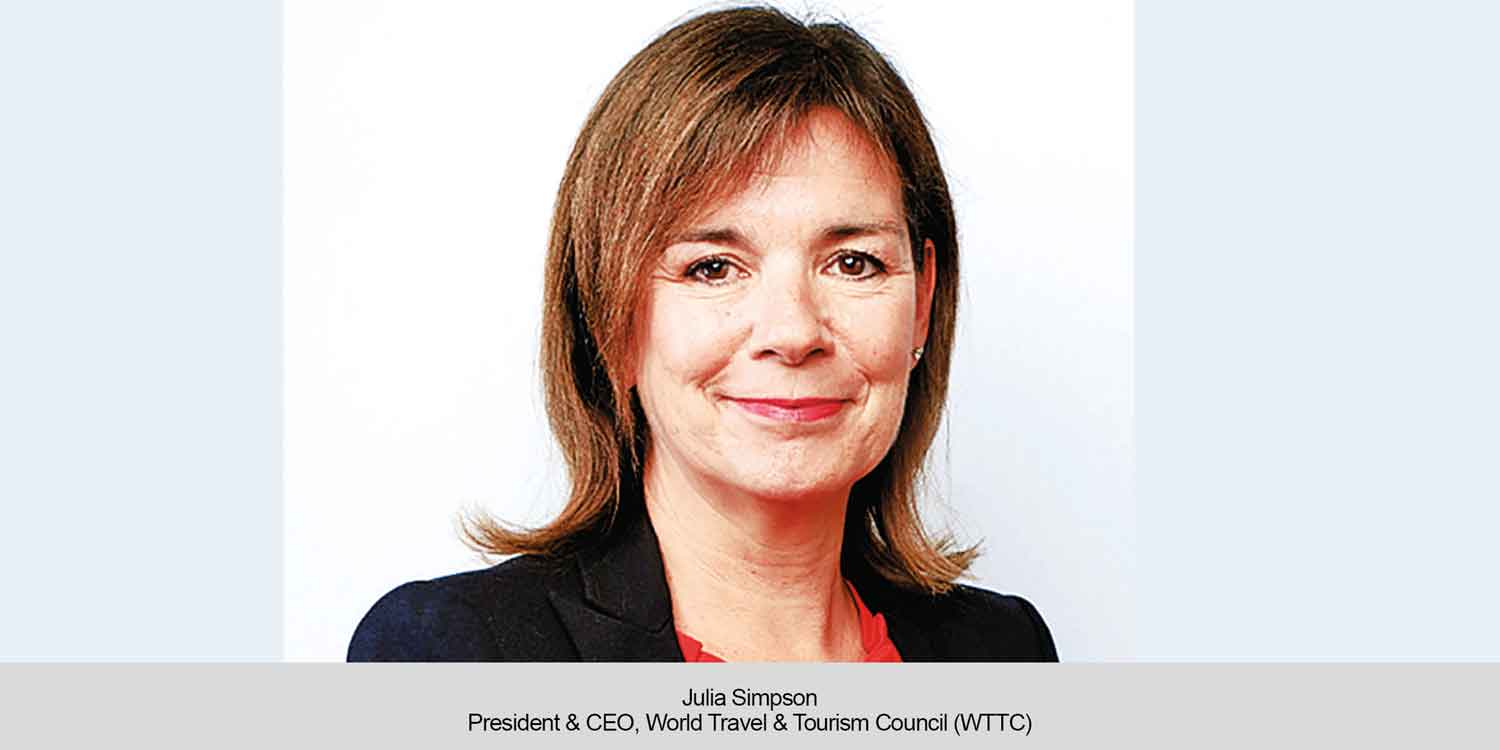The airfares have skyrocketed ever since the flights have restarted in full fervour and the government removed the initial capping on fares. While this is good news for the airlines, the industry wants them to stabilise, which doesn’t look like the case currently. Hence, as the industry is busy booking packages, the customer might just be feeling the pinch on his pocket.
Guldeep Singh Sahni
Founder President, OTOAI & MD, Weldon Tours and Travels The outbound traffic that had to go after revenge tourism, has already taken off. However, there is still a lot of volume left to go. Thus, I don’t think the fares will come down before the summer season because most flights have not returned back. Thus, the number of seats are not available. Even if we say that post-COVID, flights are nearing normalcy, the number of outbound passengers has increased a lot. The supply is not in proportion of the demand. Hence, airlines will have to struggle with Government as well to get the slots. For example, Turkish Airlines can do a lot of business in India, provided they get inroads to other cities like Chennai, Bangalore Hyderabad and Kolkata. This way competition will be created and fares would reduce.
Subhash Goyal
Chairman, STIC Travel & Air Charter, Group and Former President, IATO I don’t think the fares are going to stabilize soon because there is a shortage of international air seats, to and from India and the demand has gone up substantially. The fares will come down or will stabilize only after there is an increase in the number of seats from, and to India. This can only happen if we open the skies and allow any international airline that wants to come to India. I would suggest that since India has the leadership of G20, we should at least open the skies for all G20 countries. Once the supply of international seats increases, both to and from India, automatically the fares will start coming down. It’s a negative change and only those people are travelling who have no other choice. In such a situation, only the rich are travelling for leisure.
Agents
Anshu Tejuja, Managing Director, Ashoka Dream Holidays
The increased airfares are due to many reasons. All the airlines haven’t yet started to their full capacity and frequency like pre-covid times. Moreover the fuel prices have shot up and so has the Roe. There are fewer staff and newer employers, and there is a need to cover up losses of pandemic. All this added together has increased the cost. Like they say it takes a while for the dust to settle. I see it settling since if you book in advance or keep searching, you can be lucky to get a good fare. Irrespective of the airfares i see Indians are still booking and traveling as there has been surge in revenge travel. A few still think twice before going ahead with high fares. It should settle this year gradually.
Manoj Saraf, MD Gainwell Travel & Leisure
The airfares (both domestic and international) in general are expected to remain high for several reasons. The crude is still very high as compared to the pre-pandemic level in March 2020. The Indian rupee has depreciated almost 10 per cent as compared to the USD. All other costs including salaries and overheads have also increased substantially after the pandemic. Moreover, the airlines & hospitality Industry must recover the massive losses they incurred for two years. Even though the fare may stabilize over the next two months, they would still be substantially higher than 2020 levels. The customers have now accepted the higher level of airfares. The demand is very high despite the increased fare.
Mahendra Vakharia, MD, Pathfinder holidays and Imm. Past President-OTOAI
The aviation Industry was also severely impacted during Covid and is slowly emerging out of the challenge. However, I do not foresee the airfares reducing from the present levels unless the seat capacity on routes increases. it will continue to remain high going forward in 2023 as well, and the flyers will have to fasten their seat belt a notch tighter to cope with this. I feel the present level of airfares both for travel— domestic and international will continue to hold ground and may increase depending on the demand which is looking very good and high at present. This is not an ideal situation and levels of airfare, ironically in the past when the crude oil had crossed more than $100 a barrel, were not so high. Does industry or customers have any chance or option?
Pooja Wadhwa, Co-founder, Avant Garde Consulting
David Harvey once said, ‘The equilibrium between supply and demand is achieved only through a reaction against the upsetting of the equilibrium’. If one were to analyse with a lens of simplicity, it’s all a function of demand & supply, and how scarcity propels demand, which has been the case over the last couple of years. I suppose that was the reaction of airlines to the ‘upset of the equilibrium’. How airlines shape their fares in the coming months/ years to find the new equilibrium will depend on how demand for travel evolves, the course of which lies in our ability, collectively as an industry, to continually create aspirational value in experiences that inspire people to travel over & over again, with as much fervour as they’d had for their very first sojourn!
Alpa Jani, CEO & Founder, Ace Connect
Year 2022 began with restrictions, but ended with a high demand, as India resumed scheduled commercial flight operations in March. The airlines could not meet the rising demand, which is one of the reasons that airfares never dropped to pre-pandemic levels. Some other reasons for the surge are; increase in ATF cost, elevated crude oil prices due to geo-political conditions, rupee depreciation against the US Dollar, inflation, staff shortages and shortage of aircrafts. The airfares are currently 25-30% higher compared to 2019, and during the festive season of last year, the airfares were 62% higher compared to 2019. This trend will continue in 2023, with seasonal changes in airfares. There is a possibility of rectification for the summer of 2024.
Indiver Rastogi, President & Group Head, Global Business Travel, Thomas Cook (India) and SOTC Travel
Understandably, there is a considerable increase of approx. 20-30 per cent in airfares to popular international destinations due to high demand because of easing of restrictions. Our data indicates that despite increase in airfares, we continue to see a strong uptick for international travel compared to pre-pandemic levels. Airfares to Europe’s Switzerland, France and Spain; UK have seen a surge by 30-35 per cent, Turkiye by 20 per cent, Southeast Asia’s Singapore, Malaysia, Thailand, and Indonesia by 35 per cent; Vietnam and Cambodia by 40 per cent; also Dubai and Abu Dhabi 35 per cent and Mauritius 15 per cent. Additionally, long haul destination like Australia witnessed 20-25 per cent uptick.
Pranav Kapadia, Founder & Director Global Destinations
Post-pandemic, the tourism sector has gone though many changes including major increases in prices across the industry. It truly feels like a fresh start for all, with airlines being no exception. Airlines slowly and steadily are building back their network and are currently experiencing high load factors. Airfares are higher this year by 20-30 pre cent due to a rise in oil prices and trains have limited availability. Given that globally no one could travel in the past two years, I do believe that it is time for us to get used to the ‘new’ level of airfares, whether on domestic or international routes. Whilst we may expect some correction closer to 2024-25, the current air fare levels are an indication of what they will be like for the rest of 2023.
Ekta Watts, Director, Equator Tours and Destinations
The airfares during the pandemic had gone up drastically as the frequency of flights had gone down, but now flights have increased but the fares are still on the same lines. Stabilization of the airfares will take a few more months I believe but still will not come down to the pre-pandemic level as still, the airlines have their reasons. Though business travellers and others have come to the virtual mode, but airfare still is the most important component, be it business leisure or student. They have adapted the high airfares but have become selective, if the family wants to have a holiday in a long-haul destination are preferring short haul destinations, two family holidays in a year has curtailed down to one. It is a disadvantage for the industry.
Associations
Rajiv Mehra, President, IATO
Pricing is a question of demand and supply and even the government cannot enforce its decision on the pricing parameters. The solution lies in more aircrafts, alternate routes and last mile connectivity, on which the airlines and the government are putting their minds together. Once outbound increases in the post pandemic stage, domestic airfares may witness a decline and it also depends on the season and any event happening in a particular place. The IF factor I have outlined above, should happen once outbound is in full swing and more aircrafts are in service and should come up in the start of the Off-Peak season. It is a change based on the market forces of demand and supply. We need to investigate the supply aspect.
Anil Kalsi, Joint Secretary, TAFI
Artificial intelligence and programming by airlines to gain maximum yield have been Put in use in many ways on selling platforms. These keep airfares high and make higher fares the norm. Competing airlines don’t complain as they set to gain as well. Demand for Canada, be it for immigrants, student traffic or visiting family apart from leisure are enough to fill up flights out of India. Even via flights get sold out for Canada-bound traffic and high fares persist. For east bound, Australia takes the major traffic. Rest of the world is also a big market for Indians, since we are based in major destinations, and our leisure appetite is also huge. Indians have been paying very high fares by all means post-COVID. Unless there is fare governance, airlines out of India will make hay.
Biji Eapen, President- IAAI and Chairman & CEO- Speedwings
Air travel costs have already been higher than the pre-pandemic levels globally, worsened by the Russia- Ukraine war. Jet fuel has become very expensive, as many countries put trade restrictions on oil from Russia. Inflation has directly impacted business travel due to rising prices and changing currency values. The recession in the aviation industry could lead to an increase in airfares. Airlines will be looking to offset the decrease in demand by raising prices. Many airlines drastically downsized their staff during the pandemic, and now there is a significant pilot shortage in the USA and other countries. The convergence of these trends has caused the price inflation we have all witnessed globally. IATA expects a return to profitability for the industry this year.
Ranga Reddy, Chairman, IATO- Telangana and Andhra Pradesh Chapter
Prices have increased substantially across the world from what it was pre-COVID. It’s not just for international travel, but also for domestic and inbound. However, there are many other factors that are affecting the tourism in the country apart from airfares, like people losing jobs and lack of information. When it comes to high price, it is the case for hotels across the country. Hotels, which used to charge around `4,000 per night in 2019, are charging `10,000 per night today. However, the service standards and professional staff of many hotels has gone down. We cannot discuss these issues with any higher authority right now.
Riaz Munshi, President, ATOAI
The increased airfares depend on the demand and supply, the demand is high right now the supply is low. So, the supply has to be increase. Once supply is increased then only the fire will come down. Otherwise, this is going to range bound from around this fair only maybe 10% up or down. But most likely it’s going to remain in this area. We look forward that the numbers are increasing, and we really wanted more flights to come to existing flight numbers to a frequency to be increased. So, it all depends on that, but as of now I don’t see much changes. More people will only travel when the airfare will come down. The fares are quite high.
Sidharth Khanna, General Secretary, OTOAI
By the looks of it, I do not think the increased airfares will stabilize after post-pandemic surge settles because the airlines are playing absolutely full and we don’t see the decline in airfares for post-pandemic, however, we seriously think they should but still the flights are full. I think most post-pandemic at least a year or two to get back to normalcy because people are traveling in revenge tourism right now and everyone wants to travel, and there is an uncertainty of what is going to be back or not. So, people want to make the most of it. Within a year, if things are on a constant and they settle down, the surge in the price should come down automatically.
Sunil Kumar, President, UFTAA
The stability cannot come in place unless the demand meets the supply. Such challenges happen when the demand is more than the supply. Airlines and hotels are sitting with dynamic pricing. In the last 8-10 months, I have travelled a lot on domestic routes and have not seen any flight half empty. In 2019, it was not the case. Seats and rows used to be unoccupied. Airlines in such a scenario are not wrong in covering up the expenses that were incurred during COVID, which were beyond their ability to cope up otherwise. They are in a domain where they want to make up the losses they have gone through, as they have loans, borrowings, and many other challenges.
Technology, Rakesh Narayanan, Vice President, Regional GM (Asia Pacific), Travel Solutions Airline Sales, Sabre
We see strong airfares for domestic and international flights, including for leisure travel, which tends to book in advance, and for close-in corporate travel. It is also important to note that the average fare disparity between purchase dates is very small. Historically, there has been a more pronounced difference in the average fares based on advance purchase periods. Airlines are continuing to face challenges in bringing capacity back. However, higher air fares encourage carriers to increase the number of seats they plan to fly. We are already seeing this with the large US network carriers.
Hotel
Bhagwati Pant, General Manager, The Centrum, Lucknow
Most people missed out on an international summer holiday in 2022 too. But that is expected to change in 2023 with a huge jet-setting surge. There have been various reports claiming that international travel is set for a big comeback. This could send flight prices soaring in 2023. Out of a number of factors that will contribute to high prices in 2023 one of the most significant, and perhaps the most obvious, is a surge in demand that could outstrip supply. The demand is going to outrun the supply of seats for all of 2023, unless the economy goes into a much more serious recession.
NTO
Seema Kadam, Regional Director, India, Los Angeles Tourism & Convention Board
While Indian travelers can be cost-conscious when it comes to planning a trip, travel demand has returned to pre-pandemic levels despite the heightened airfares caused by rising fuel costs, inflation and staff shortages. Indian travelers have not been discouraged by these costs, as many have experienced increased savings throughout the pandemic to travel to their dream destination in 2023. With fleet expansions continuing and new routes from several carriers expected in the coming months, we anticipate a stabilization in airfare and flight inventory by early 2024.
 TravTalk India Online Magazine
TravTalk India Online Magazine







